Research on the Value Assessment System of Chinese Rural Preservation and Inheritance—The Example of Rural in the Western Liao River Basin in Inner Mongolia
Abstract
1. Introduction
2. Literature Review
2.1. Rural
2.2. Rural Preservation and Inheritance
2.3. Research on the Value Assessment of Rural Preservation and Inheritance
3. Problem Analysis and Contribution of This Paper
3.1. Problem Analysis
3.1.1. Problems of Domestic and International Research
3.1.2. Realistic Problems
3.2. Demand Analysis
3.3. Contribution of This Paper
4. Methodology
4.1. Holistic Research Methodology
4.2. Research Design
4.3. Analytical Strategy
4.4. Model Construction
4.4.1. EBM Model
4.4.2. GML Index
4.4.3. Region-Wide EBM-GML Model
4.5. Sources and Types of Data Used
4.6. Data Collection and Processing
5. Empirical Analysis
5.1. Scope and Object of the Study
5.1.1. Scope of the Study
5.1.2. Research Object
5.2. Indicator System
5.2.1. Theoretical Basis of Index System Construction
5.2.2. Indicator System Construction
5.3. Analysis of Results
5.3.1. Assessment Value Analysis
5.3.2. GML Index Analysis
6. Conclusions and Countermeasure Suggestions
Author Contributions
Funding
Data Availability Statement
Conflicts of Interest
References
- Li, X. Research on the Lisving Preservation and Development of Xinbaozi Rural in Huludao City under the Strategy of Rural Revitalization. Master’s Thesis, Shenyang Jianzhu University, Shenyang, China, 2022; p. 13. [Google Scholar] [CrossRef]
- Lu, Q. Research on the Wisdom of Cultural Space Construction and Preservation and Inheritance of Traditional Rurals along the Yellow River in Shaanxi. Master’s Thesis, Xi’an University of Architecture and Technology, Xi’an, China, 2022; pp. 24–25. [Google Scholar] [CrossRef]
- Hu, J. The dilemma and the way out of the construction of non-heritage cultural preservation system in the context of rural revitalization strategy. Cult. Geogra 2023, 2, 61–64. [Google Scholar]
- Yang, X. Study on the change of habitat and living heritage strategy of traditional rurals in the Qiantang River Basin. Acad. Beijing China 2022, 34–35. [Google Scholar] [CrossRef]
- Jiang, Z. Current thinking on the preservation of rural cultural heritage and the development of creative industries. Cult. Forum 2022, 12, 86–95. [Google Scholar]
- Burchardt, J. State and Society in the English Rural: The Rural Community Movement 1918–39. Rural Hist. 2012, 23, 56–67. [Google Scholar] [CrossRef]
- Mulder, J.; Brent, A.C. Selection of Sustainable Rural Agriculture Projects in South Africa: Case Studies in the Land Care Programme. J. Sustain. Agric. 2006, 28, 22–24. [Google Scholar] [CrossRef]
- Lynn, M. The Return of Community to Rural Human Services. Rural Soc. 2004, 14, 13–15. [Google Scholar] [CrossRef]
- Liu, P. Research on the Development and Utilization of Hunan Rural Cultural Landscape Resources in the Construction of New Rural; Hunan Forum on Building a New Socialist Countryside: Changsha, China, 2006; pp. 12–13. [Google Scholar]
- Liu, Q. The preservation and inheritance of intangible cultural heritage in China from the perspective of Marxist cultural outlook. Univ. Guangzhou China 2019, 23–24. [Google Scholar] [CrossRef]
- Tovey, H. Introduction: Rural Sustainable Development in the Knowledge Society Era. Sociol. Rural. 2008, 48, 185–199. [Google Scholar] [CrossRef]
- Káposzta, J.; Nagy, H. The Major Relationships in the Economic Growth of rural Space. Eur. Ctry. 2022, 14, 67–86. [Google Scholar] [CrossRef]
- Parlato, M.C.; Valenti, F.; Porto, S.M. Sustainable Promotion of Traditional Rural Buildings as Built Heritage Attractions: A Heritage Interpretation Methodology Applied in South Italy. Sustainability 2022, 14, 16206. [Google Scholar] [CrossRef]
- Khamung, R. The Investigation of Rural Cultural Heritage and Implications to Agritourism Strategies for Preservation in Rural Chiangkhan, Thailand. J. Tour. Leis. Stud. 2016, 1, 13–36. [Google Scholar] [CrossRef]
- Heaphy, L.; Scott, M. Path dependence, ‘lock-in’ and rural housing outcomes: Insights from Ireland. Eur. Plan. Stud. 2022, 30, 2412–2432. [Google Scholar] [CrossRef]
- Hu, M.; Dong, W. Study on the application of GIS technology in the preservation planning of historical districts. Archit. Sci. 2004, 12, 63–65. [Google Scholar]
- Liu, C.; Liu, P. Research on the preservation and development of ancient rurals in the context of economic construction in the mountainous regions of Beijing. Econ. Geogra 2011, 31, 1923–1929. [Google Scholar]
- Hu, B. The current situation of traditional rural evolution is worrying—A survey and return visit from the front line of rural areas. People Forum 2015, 14, 3. [Google Scholar]
- Feng, G.; Sun, Y. My cultural preservation is also an emotional act. Cult. Forum 2018, 248, 109–114. [Google Scholar]
- Rolínek, L.; Cudlínová, E.; Klufová, R.; Leitmanová, I.F.; Jílek, M.; Řehoř, P. Model strategy for village development in the Czech Republic. J. Cent. Eur. Agric. 2015, 16, 88–90. [Google Scholar] [CrossRef]
- Nugraha, L.F.; Sulistyowati, L.; Setiawan, I.; Noor, T.I. Alternative Community-Based Rural Development Strategies in Indonesia:Using Multicriteria Decision Analysis. Agriculture 2022, 12, 1903. [Google Scholar] [CrossRef]
- Kusrini, E. Strategy of Tourist Rural Development in Nongkosawit Sub-District, Gunungpati District, Semarang City. Econ. Dev. Anal. J. 2018, 6, 46–48. [Google Scholar]
- Bérczi, S.; Szabó, Z.; Sallay, Á. Strategic Directions:Evaluation of Rural Development Strategies in the Case of Applicants for the Hungarian Rural Renewal Award. Land 2022, 11, 681. [Google Scholar] [CrossRef]
- Kumar, A. Rural Development Practice and History in Ghana and India: Some Comments. Community. Int. J. Community Soc. Dev. 2022, 4, 12–14. [Google Scholar] [CrossRef]
- Ruan, Y. A long way to go for heritage preservation. Rural Cult. 2004, 34, 6–8. [Google Scholar]
- Zhao, Y.; Wang, J. Research on traditional rural settlement planning based on morphological integrity—The application of settlement performance enhancement planning techniques. Urban Plan 2018, 42, 33–40. [Google Scholar]
- Xie, H. Research on the spatially adaptive development model of rural rurals in the northern Qinling Mountains. Univ. Xi’an China 2017, 12, 3–25. [Google Scholar]
- Xie, H. A preliminary study on the ecological adaptive development model of rural space in shallow mountainous areas at the edge of the City. Archit. Sci. 2022, 54, 95–102. [Google Scholar]
- Guo, Y.; Yao, Y.; Li, G. Spatial strategies for reshaping rural comfort with greenway networks:the case of Zhenjiang Town. Archit. Sci. 2022, 54, 76–84. [Google Scholar]
- Wu, F.; Liao, Y.; Wu, X. Study on the spatial development of rural settlements at the southern foot of the Qinling Mountains based on the definition of small watersheds. Archit. Sci. 2018, 50, 249–257. [Google Scholar]
- Hodge, I.; Midmore, P. Models of rural development and approaches to analysis evaluation and decision-making. Économie Rural. 2008, 3, 23–38. [Google Scholar] [CrossRef]
- Nemes, G. Integrated Rural Development-The Concept and Its Operation; Bright Publishers: New York, NY, USA, 2005; Volume 34, pp. 21–22. [Google Scholar]
- Díez, M.A.; Izquierdo, B.; Malagón, E. Increasing the Use of Evaluation through Participation: The experience of a rural sustainable development plan evaluation. Environ. Policy Gov. 2016, 26, 33–35. [Google Scholar] [CrossRef]
- Prus, B.; Wilkosz-Mamcarczyk, M.; Salata, T. Landmarks as Cultural Heritage Assets Affecting the Distribution of Settlements in Rural Areas—An Analysis Based on LIDAR DTM, Digital Photographs, and Historical Maps. Remote Sens. 2020, 12, 1778. [Google Scholar] [CrossRef]
- Li, Y.T.; Tian, L.; Zhao, L. Research on the value assessment of traditional rurals in Beijing and their preservation strategies based on K-modes. Town Constr. 2019, 37, 22–29. [Google Scholar]
- Tian, J.; Jiang, Q. Research on regional survey methods and evaluation system of traditional wind and landscape rurals and towns--a survey of traditional wind and landscape rurals and towns in Kunming City as an example. Town Constr. 2016, 12, 27–32. [Google Scholar]
- Liu, Z. Study on the evaluation of the value of Chinese traditional rurals as world cultural heritage. Soc. Sci. 2021, 42, 52–58. [Google Scholar]
- Beckmann, M.J.; Charnes, A. An Introduction to Linear Programing; Charnes, A., Cooper, W.W., Henderson, A., Eds.; Macmillan Publishers: London, UK, 1954; Volume 62, pp. 13–15. [Google Scholar]
- Charnes, A.; Cooper, W.W.; Rhodes, E. Evaluating Program and Managerial Efficiency: An Application of Data Envelopment Analysis to Program Follow Through. Manag. Sci. 1981, 27, 30–31. [Google Scholar] [CrossRef]
- Tone, K. A slacks-based measure of efficiency in data envelopment analysis. Eur. J. Oper. Res. 2001, 130, 12–13. [Google Scholar] [CrossRef]
- Kumar, S. Environmentally sensitive productivity growth: A overall analysis using Malmquist-Luenberger index. Ecol. Econ. 2006, 56, 34–36. [Google Scholar] [CrossRef]
- Inner Mongolia Bureau of Statistics. Inner Mongolia Statistical Yearbook 2022; Beijing, China. 2022; pp. 12–14. Available online: http://tj.nmg.gov.cn/files_pub/content/PAGEPACK/83e5521da4e94d50ab45483b58e5fa7e/indexch.htm?slh=true (accessed on 9 April 2023).
- Department of Water Resources of Inner Mongolia. Inner Mongolia Water Conservancy Yearbook (2021); Beijing, China. 2021, pp. 24–26. Available online: http://www.nmgqq.com.cn/xinxidongtai/gongzuodongtai/qunei/2022-12-31/25702.html (accessed on 9 April 2023).
- Office of the People’s Government of Balinzuo Qi. Yearbook of Balinzuo Qi 2021; Chinese Literature and History Press: Beijing, China, 2021; pp. 54–55. Available online: http://product.dangdang.com/11160590691.html (accessed on 9 April 2023).
- Central Office and the State Office. Opinions on Strengthening the Preservation and Inheritance of History and Culture in Urban and Rural Construction; Central Office and the State Office: Beijing, China, 2021; Volume 11, p. 3. [Google Scholar]
- Cobb, C.W.; Douglas, P.H. A Theory of Production. Am. Econ. Rev. 1928, 18, 12–13. [Google Scholar]
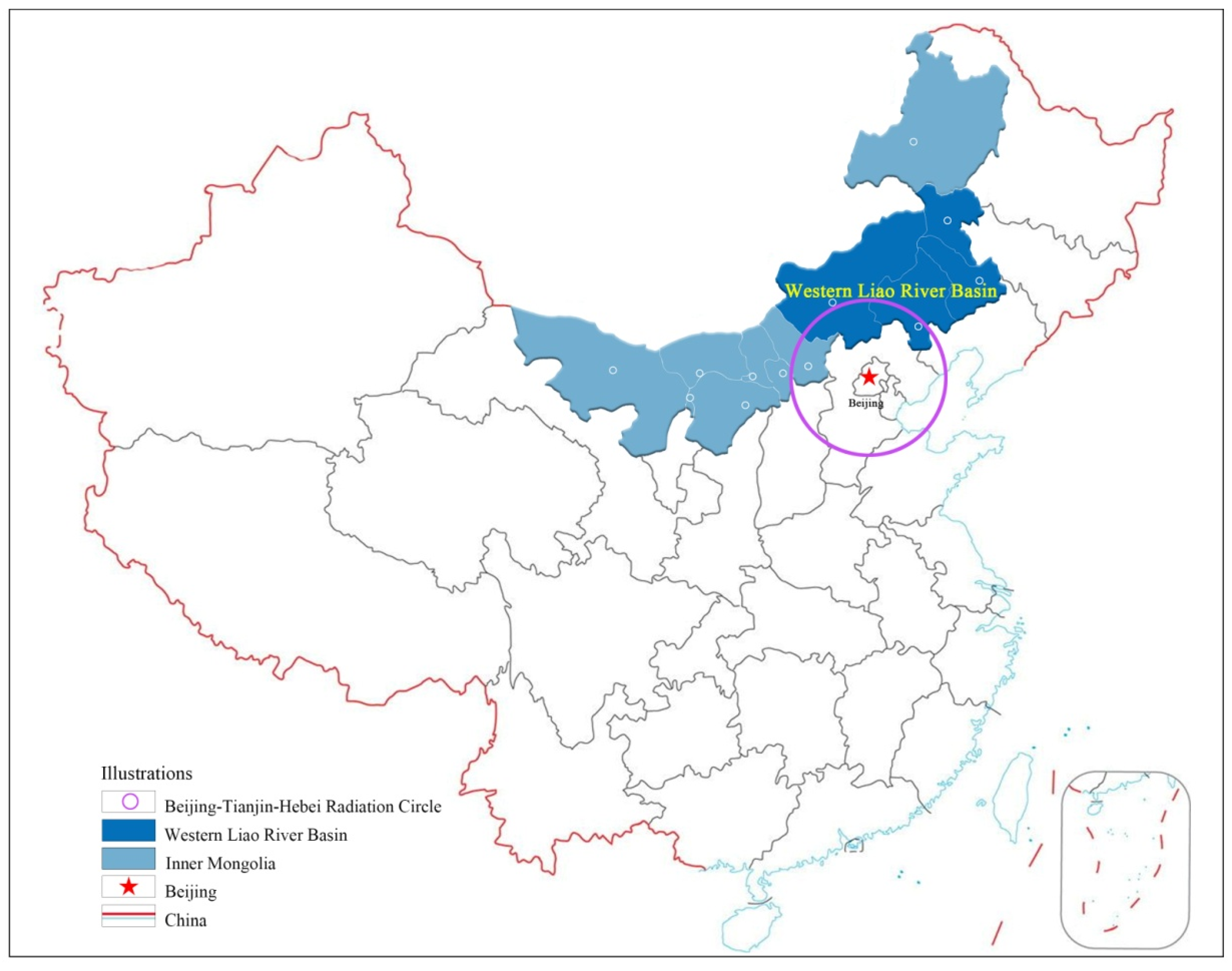
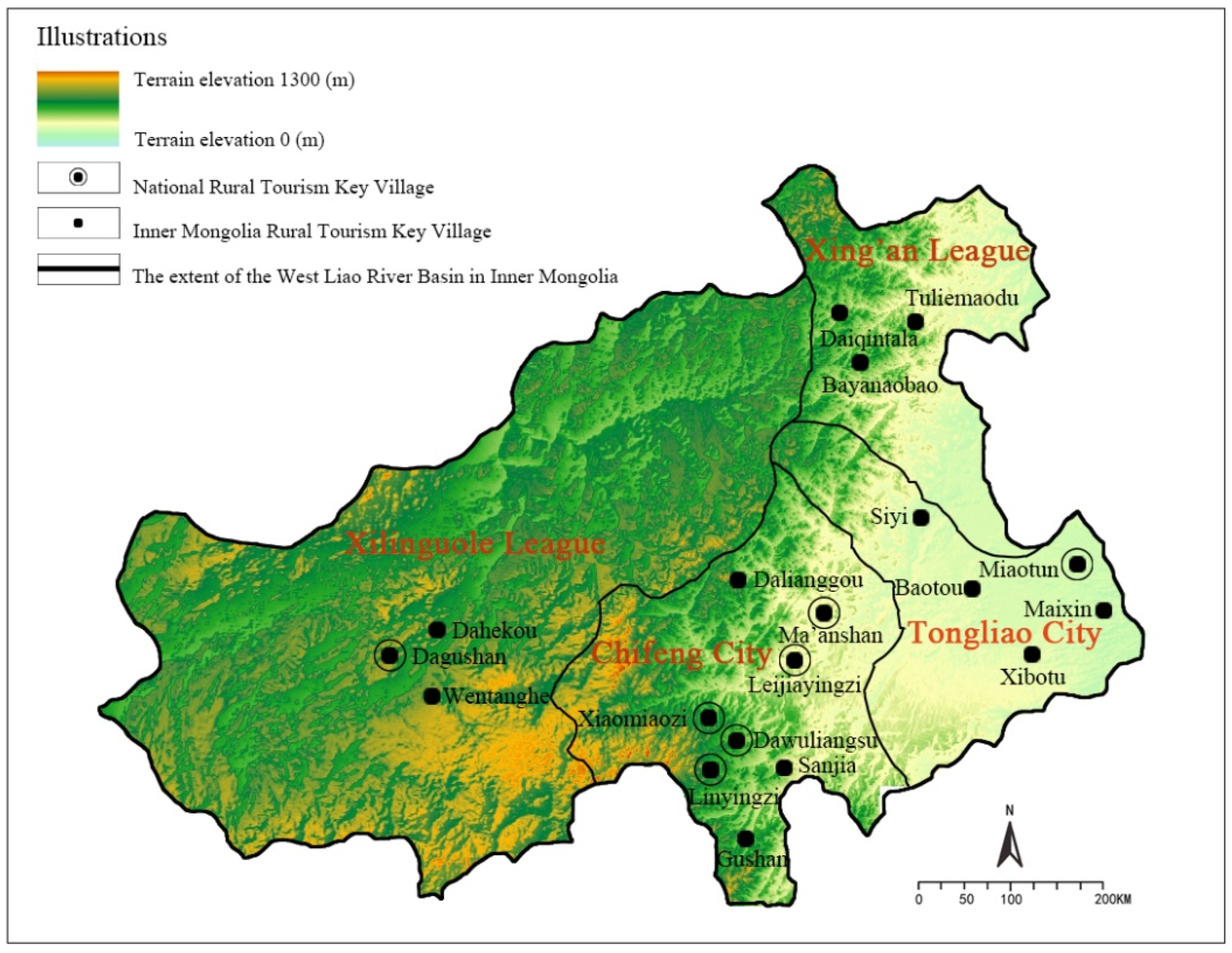
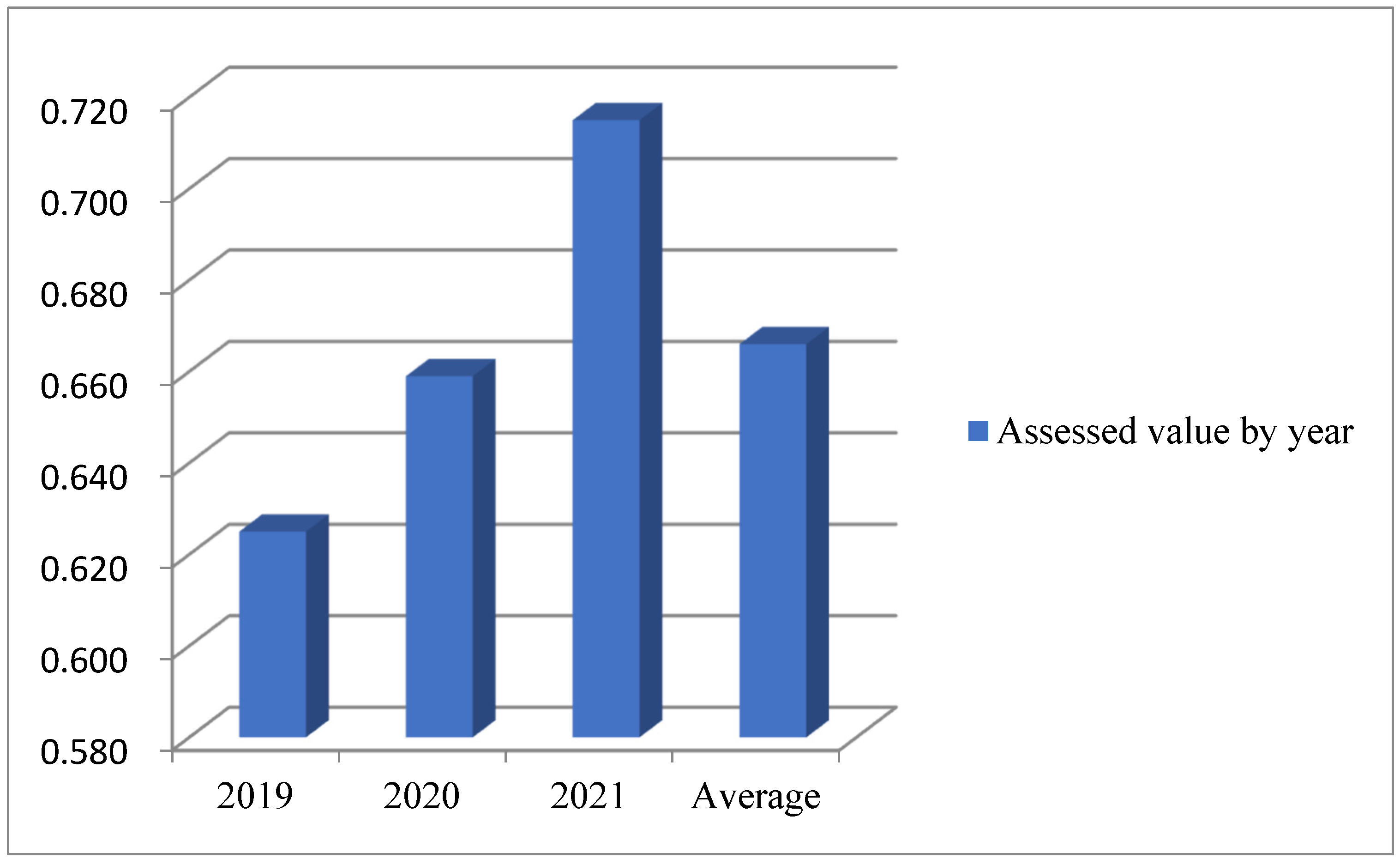
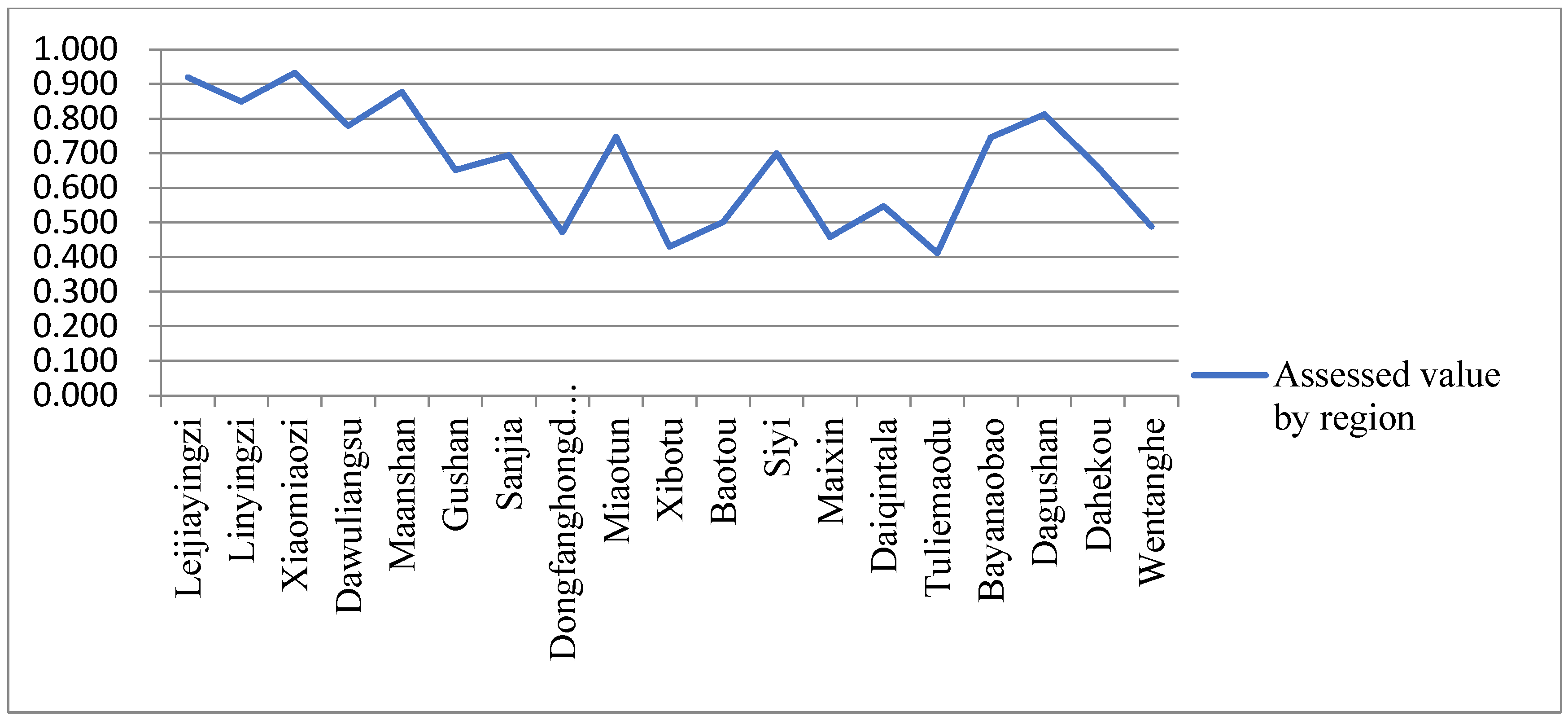
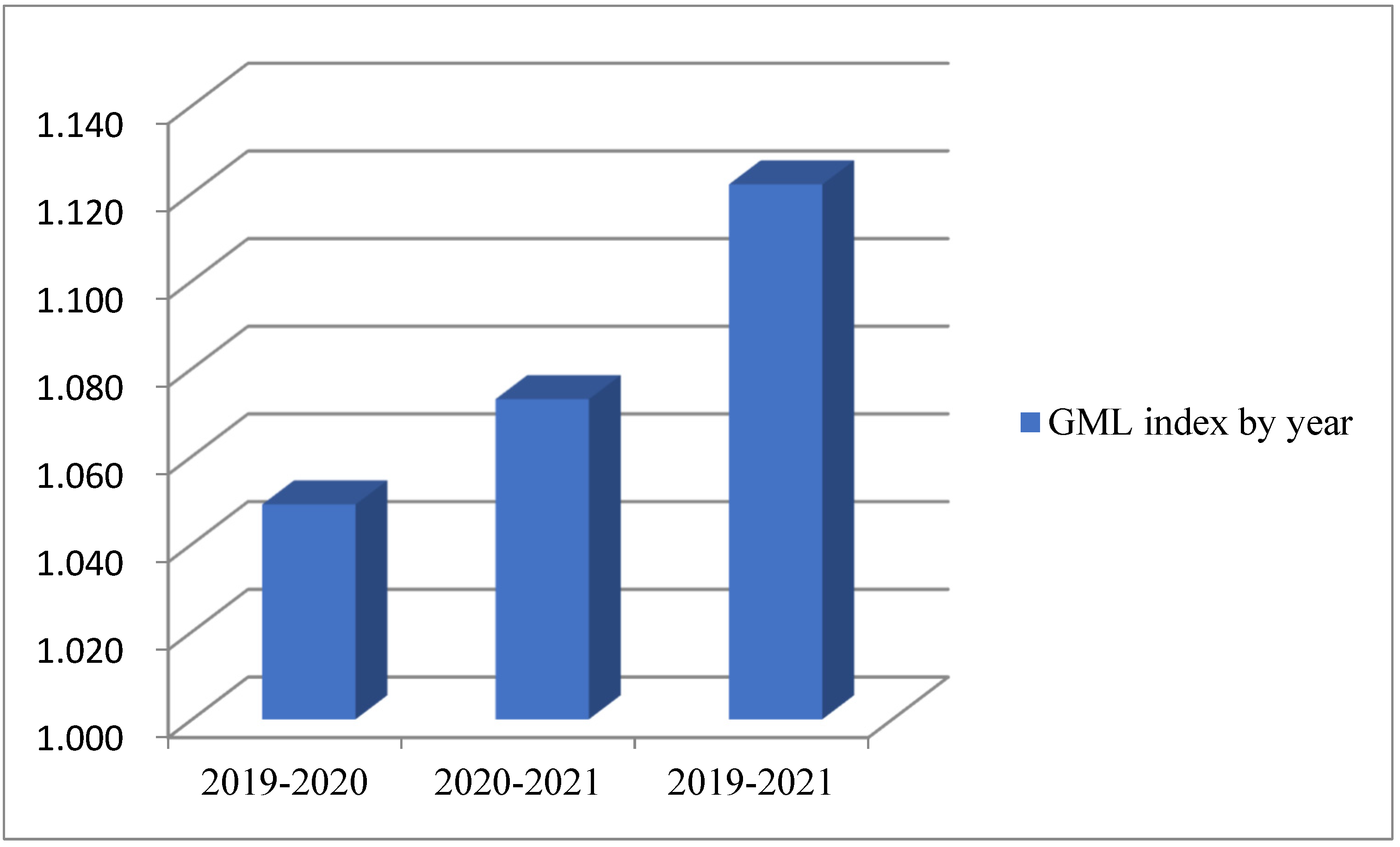
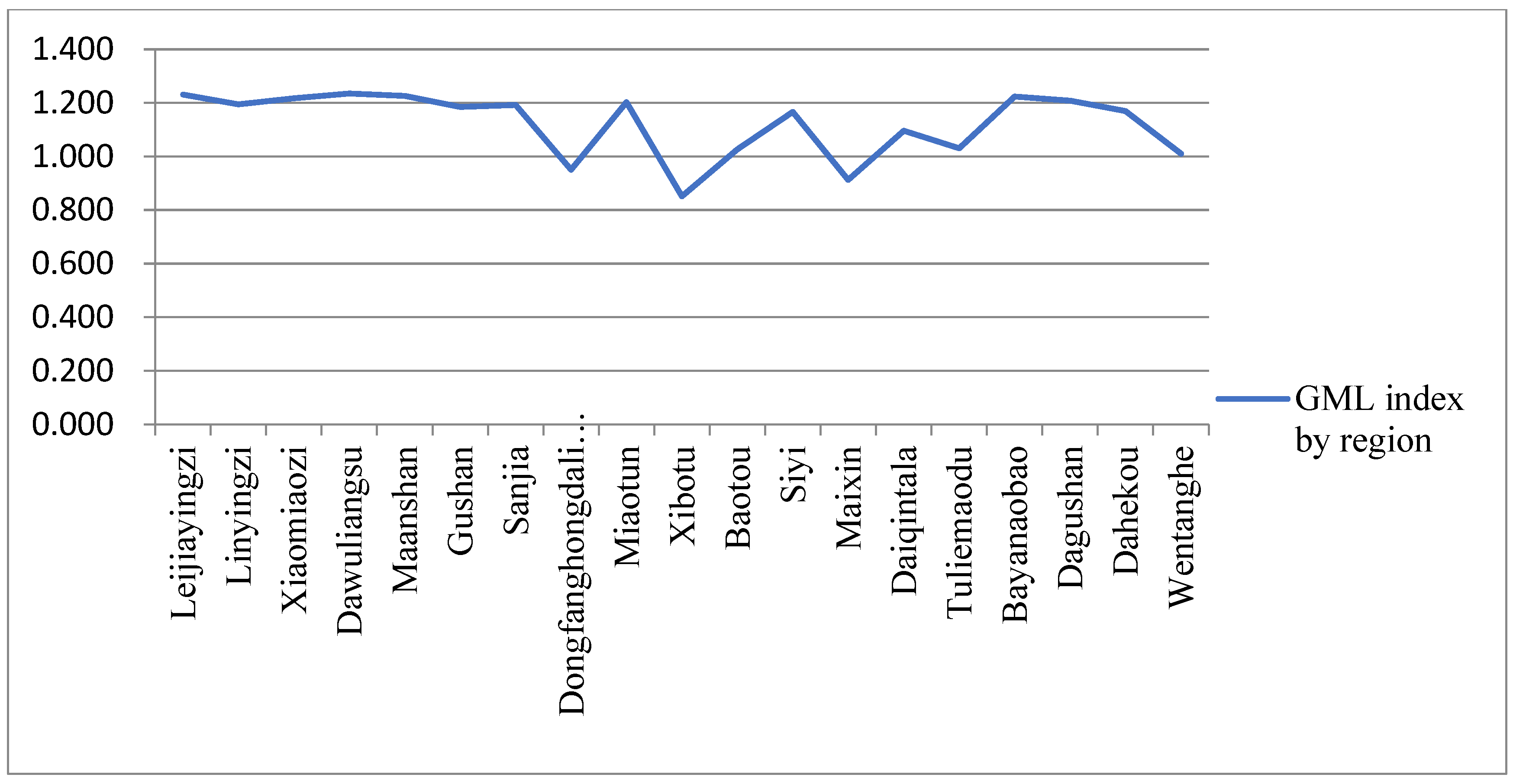
| Province | City | Village Name | Year/Batch | Grade | Rating Status |
|---|---|---|---|---|---|
| Inner Mongolia | Chifeng | Leijiayingzi Village, Xiqiao Town, Kalaqin Qi | 2019/1 | National | Rural tourism key villages |
| Lingyingzi Village, Shixiang Town, Kalaqin Qi | 2020/2 | National | |||
| Xiaomiaozi Village, Daimiao Town, Songshan District | 2021/3 | National | |||
| Dawuliangsu Village, Laofu Town, Songshan District | 2022/4 | National | |||
| Ma’anshan Village, Henan Street, Kalaqin Qi | 2022/4 | National | |||
| Gushan Village, Meilin Town, Kalaqin Qi | 2021/1 | Inner Mongolia | |||
| Sanjia Village, Wangfu Town, Kalaqin Qi | 2022/2 | Inner Mongolia | |||
| Dongfang Hong Daliangou Village, Biliutai Town, Balinzuo Qi | 2022/2 | Inner Mongolia | |||
| Tongliao | Miaotun Village, Bayintala Sumu, Naiman Qi | 2020/2 | National | ||
| Xibotu Village, Bayintala Sumu, Naiman Qi | 2021/1 | Inner Mongolia | |||
| Baotou Gacha, Baiyintala Sumu, Naiman Qi | 2021/1 | Inner Mongolia | |||
| Siyi Village, Qinglongshan Town, Naiman Qi | 2022/2 | Inner Mongolia | |||
| Maixin Village, Maixin Town, Kailu County | 2022/2 | Inner Mongolia | |||
| Xing’an | Daiqintala Gacha, Daiqintala Sumu, Ke’right Central Qi | 2021/1 | Inner Mongolia | ||
| Tuliemaodu Gacha, Tuliemaodu Town, Keyouzhong Qi | 2021/1 | Inner Mongolia | |||
| Bayanaobao Gacha, Emmuting Gaol Sumu, Keyouzhong Qi | 2022/2 | Inner Mongolia | |||
| Xilinguole | Dagushan Village, Luanyuan Town, Duolun County | 2020/2 | National | ||
| Dahekou Village, Luanyuan Town, Duolun County | 2021/1 | Inner Mongolia | |||
| Wentanghe Village, Luanyuan Town, Duolun County | 2021/1 | Inner Mongolia |
| Indicators | Tier 1 Indicators | Secondary Indicators | Tertiary Indicators |
|---|---|---|---|
| Input Indicators | Workforce | Talent Team Level | Number of leaders (numbers) |
| Number of technical staff and basic management (numbers) | |||
| Capital | Preservation funds | Financial funds (million yuan) | |
| Social funds (million yuan) | |||
| Expected Output Indicators | Strong preservation | Promote the revitalization of utilization | Number of revitalized and utilized heritage buildings(numbers) |
| Number of revitalized and utilized agricultural cultural heritage and irrigation engineering heritage (numbers) | |||
| Number of revitalized and utilized intangible cultural heritage (numbers) | |||
| Integration into rural construction | Number of supporting infrastructure and public service facilities (numbers) | ||
| Promotion of historical and cultural situation | Number of historical and cultural display lines, corridors, and networks (numbers) | ||
| Number of cultural theme activities (times) | |||
| Effective management | Strengthen the coordination of the situation | Number of co-management departments (numbers) | |
| Number of overall preservations of historical cultural heritage across the region(numbers) | |||
| Situation of sound management mechanism | Optimize the number of matters for approval and management (items) | ||
| Number of positive and negative lists of project access (numbers) | |||
| Promoting multi-stakeholder engagement | Number of multi-participant subjects(numbers) | ||
| Reinforcing the incentive situation | Number of typical cases of publicity and promotion (numbers) | ||
| Number of rewarding organizations and individuals (numbers) | |||
| Strengthen the supervision and inspection situation | Number of inspections (times) | ||
| Number of periodic assessments (times) | |||
| Non-expected output indicators | Inadequate preservation | Destruction and demolition | Number of old trees cut down (trees) |
| Number of alterations or encroachments on rivers and lakes(numbers) | |||
| Number of old buildings and ancient dwellings demolished (numbers) | |||
| Ineffective management | Assessment accountability | Number of listed as endangered and withdrawn from the preservation list (numbers) | |
| Number of responsible units and responsible persons punished (numbers) |
| Serial Number | Rural Name | City of Affiliation | 2019 | 2020 | 2021 | Average Value | Rank | Type |
|---|---|---|---|---|---|---|---|---|
| 1 | Leijiayingzi | Chifeng | 0.812 | 0.946 | 1.000 | 0.919 | 2 | Decelerated ascent |
| 2 | Linyingzi | Chifeng | 0.792 | 0.810 | 0.945 | 0.849 | 4 | Accelerated ascent |
| 3 | Xiaomiaozi | Chifeng | 0.822 | 0.975 | 1.000 | 0.932 | 1 | Decelerated ascent |
| 4 | Dawuliangsu | Chifeng | 0.709 | 0.751 | 0.876 | 0.779 | 6 | Accelerated ascent |
| 5 | Ma’anshan | Chifeng | 0.805 | 0.838 | 0.987 | 0.877 | 3 | Accelerated ascent |
| 6 | Gushan | Chifeng | 0.608 | 0.624 | 0.721 | 0.651 | 12 | Accelerated ascent |
| 7 | Sanjia | Chifeng | 0.662 | 0.630 | 0.789 | 0.694 | 10 | Fluctuating |
| 8 | Dalianggou | Chifeng | 0.481 | 0.463 | 0.457 | 0.472 | 16 | Decelerated decline |
| 9 | Miaotun | Tongliao | 0.683 | 0.741 | 0.821 | 0.748 | 7 | Accelerated ascent |
| 10 | Xibotu | Tongliao | 0.452 | 0.407 | 0.385 | 0.430 | 18 | Decelerated decline |
| 11 | Baotou | Tongliao | 0.493 | 0.503 | 0.506 | 0.501 | 14 | Decelerated ascent |
| 12 | Siyi | Tongliao | 0.674 | 0.642 | 0.785 | 0.700 | 9 | Fluctuating |
| 13 | Maixin | Tongliao | 0.478 | 0.461 | 0.436 | 0.458 | 17 | Accelerated decline |
| 14 | Daiqintala | Xing’an | 0.533 | 0.523 | 0.584 | 0.547 | 13 | Fluctuating |
| 15 | Tuliemaodu | Xing’an | 0.401 | 0.421 | 0.413 | 0.412 | 19 | Fluctuating |
| 16 | Bayanaobao | Xing’an | 0.672 | 0.741 | 0.822 | 0.745 | 8 | Accelerated ascent |
| 17 | Dagushan | Xilinguole | 0.730 | 0.825 | 0.882 | 0.812 | 5 | Decelerated ascent |
| 18 | Dahekou | Xilinguole | 0.613 | 0.651 | 0.717 | 0.660 | 11 | Accelerated ascent |
| 19 | Wentanghe | Xilinguole | 0.446 | 0.567 | 0.451 | 0.488 | 15 | Fluctuating |
| Average | 0.625 | 0.659 | 0.715 | 0.666 |
| Serial Number | Rural Name | City of Affiliation | 2019–2020 | 2020–2021 | 2019–2021 | Rank |
|---|---|---|---|---|---|---|
| 1 | Leijiayingzi | Chifeng | 1.165 | 1.057 | 1.231 | 2 |
| 2 | Linyingzi | Chifeng | 1.023 | 1.167 | 1.194 | 8 |
| 3 | Xiaomiaozi | Chifeng | 1.186 | 1.026 | 1.217 | 5 |
| 4 | Dawuliangsu | Chifeng | 1.059 | 1.166 | 1.235 | 1 |
| 5 | Ma’anshan | Chifeng | 1.041 | 1.178 | 1.226 | 3 |
| 6 | Gushan | Chifeng | 1.026 | 1.155 | 1.185 | 10 |
| 7 | Sanjia | Chifeng | 0.952 | 1.252 | 1.192 | 9 |
| 8 | Dalianggou | Chifeng | 0.963 | 0.987 | 0.95 | 17 |
| 9 | Miaotun | Tongliao | 1.085 | 1.108 | 1.202 | 7 |
| 10 | Xibotu | Tongliao | 0.9 | 0.946 | 0.851 | 19 |
| 11 | Baotou | Tongliao | 1.02 | 1.006 | 1.026 | 15 |
| 12 | Siyi | Tongliao | 0.953 | 1.223 | 1.166 | 12 |
| 13 | Maixin | Tongliao | 0.964 | 0.946 | 0.912 | 18 |
| 14 | Daiqintala | Xing’an | 0.981 | 1.117 | 1.096 | 13 |
| 15 | Tuliemaodu | Xing’an | 1.05 | 0.981 | 1.03 | 14 |
| 16 | Bayanaobao | Xing’an | 1.103 | 1.109 | 1.223 | 4 |
| 17 | Dagushan | Xilinguole | 1.13 | 1.069 | 1.208 | 6 |
| 18 | Dahekou | Xilinguole | 1.062 | 1.101 | 1.169 | 11 |
| 19 | Wentanghe | Xilinguole | 1.271 | 0.795 | 1.01 | 16 |
| Average | 1.049 | 1.073 | 1.122 |
Disclaimer/Publisher’s Note: The statements, opinions and data contained in all publications are solely those of the individual author(s) and contributor(s) and not of MDPI and/or the editor(s). MDPI and/or the editor(s) disclaim responsibility for any injury to people or property resulting from any ideas, methods, instructions or products referred to in the content. |
© 2023 by the authors. Licensee MDPI, Basel, Switzerland. This article is an open access article distributed under the terms and conditions of the Creative Commons Attribution (CC BY) license (https://creativecommons.org/licenses/by/4.0/).
Share and Cite
Li, J.; Li, J.; Zhang, P. Research on the Value Assessment System of Chinese Rural Preservation and Inheritance—The Example of Rural in the Western Liao River Basin in Inner Mongolia. Buildings 2023, 13, 1104. https://doi.org/10.3390/buildings13041104
Li J, Li J, Zhang P. Research on the Value Assessment System of Chinese Rural Preservation and Inheritance—The Example of Rural in the Western Liao River Basin in Inner Mongolia. Buildings. 2023; 13(4):1104. https://doi.org/10.3390/buildings13041104
Chicago/Turabian StyleLi, Jiajing, Jianing Li, and Pei Zhang. 2023. "Research on the Value Assessment System of Chinese Rural Preservation and Inheritance—The Example of Rural in the Western Liao River Basin in Inner Mongolia" Buildings 13, no. 4: 1104. https://doi.org/10.3390/buildings13041104
APA StyleLi, J., Li, J., & Zhang, P. (2023). Research on the Value Assessment System of Chinese Rural Preservation and Inheritance—The Example of Rural in the Western Liao River Basin in Inner Mongolia. Buildings, 13(4), 1104. https://doi.org/10.3390/buildings13041104






